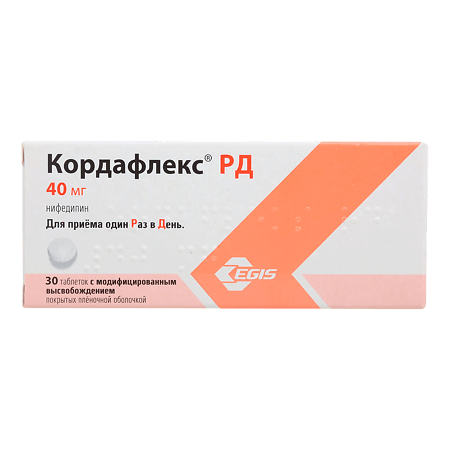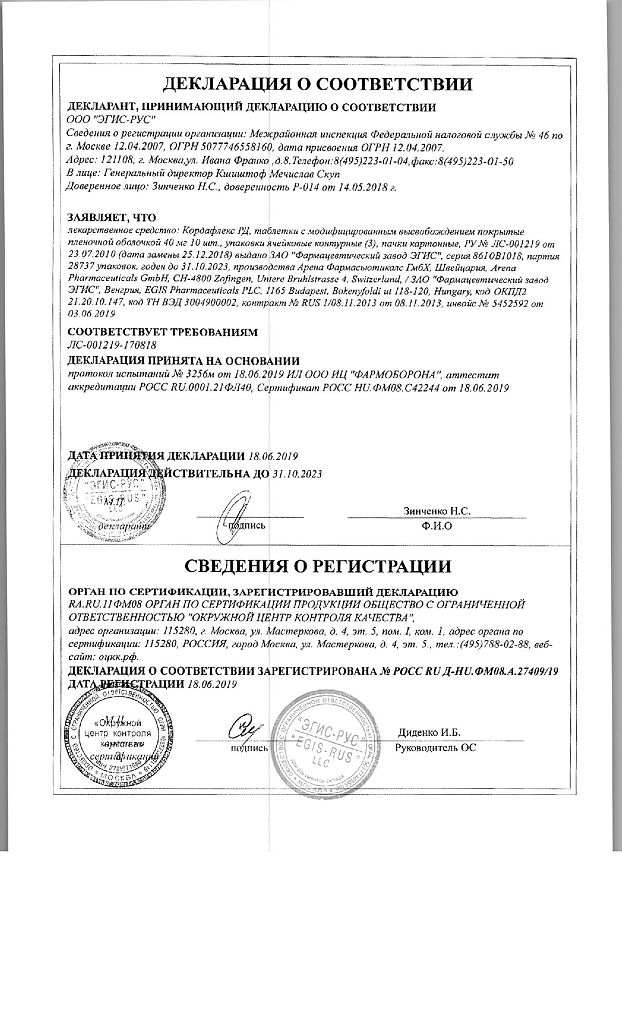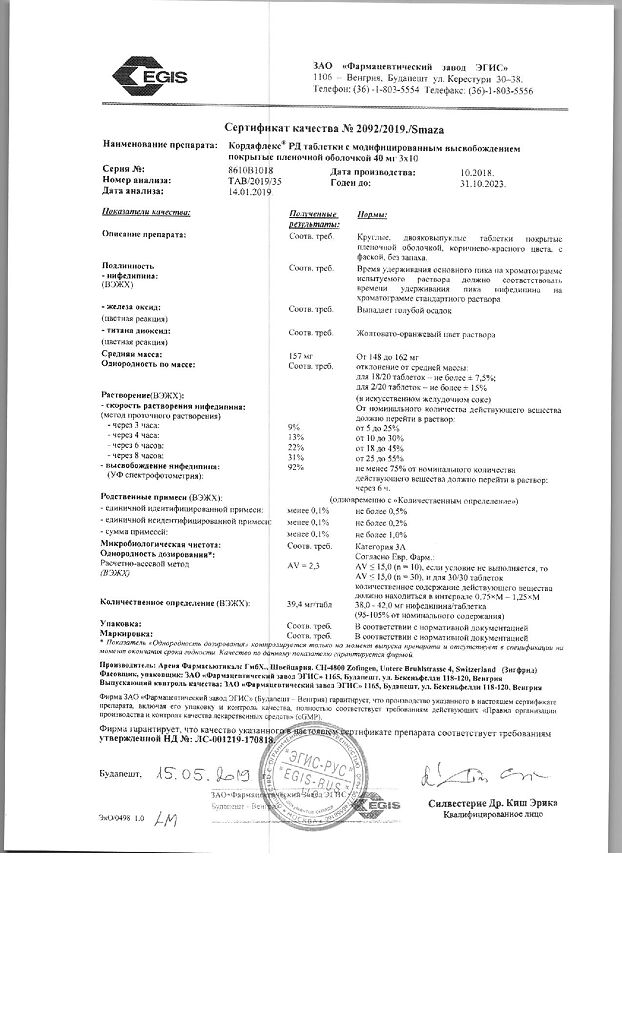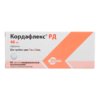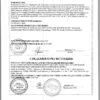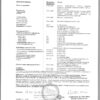No products in the cart.
Cordaflex RD, 40 mg 30 pcs
€1.00
Out of stock
(E-mail when Stock is available)
Description
CORDAFLEX RD is a selective slow calcium channel blocker, 1,4-dihydropyridine derivative. It has antihypertensive and antianginal action. Nifedipine reduces flow of extracellular calcium ions inside cardiomyocytes and smooth muscle cells of coronary and peripheral arteries.
In therapeutic doses it normalizes the transmembrane flow of calcium ions which is disturbed in a number of pathological conditions, especially in arterial hypertension. It reduces spasm and dilates coronary and peripheral arterial vessels, decreases PPS, reduces post-load and myocardial oxygen demand. At the same time, it improves blood supply to ischemic myocardial areas without development of the “bypass” syndrome and increases the number of functioning collaterals.
Nifedipine has almost no effect on sinoatrial and AV nodes and has neither pro- nor antiarrhythmic action. It has no effect on venous tone. Nifedipine increases renal blood flow, causing moderate natriuresis. At high doses, it inhibits the release of calcium ions from intracellular depots. It decreases quantity of functioning calcium channels without affecting time of their activation, inactivation and recovery.
After single use of Cordaflex in the form of sustained-action tablets the clinical effect is developed in 20 minutes, the duration of clinical effect is 12-24 hours.
Indications
Indications
arterial hypertension of various origins, including hypertensive crises;
IHD: for the prevention of attacks in various forms of angina, incl. angiospastic;
Raynaud’s syndrome.
Pharmacological effect
Pharmacological effect
CORDAFLEX RD is a selective blocker of slow calcium channels, a 1,4-dihydropyridine derivative. Has antihypertensive and antianginal effects. Nifedipine reduces the flow of extracellular calcium ions into cardiomyocytes and smooth muscle cells of the coronary and peripheral arteries.
In therapeutic doses, it normalizes the transmembrane current of calcium ions, which is disturbed in a number of pathological conditions, primarily in arterial hypertension. Reduces spasm and dilates coronary and peripheral arterial vessels, reduces peripheral vascular resistance, reduces afterload and myocardial oxygen demand. At the same time, it improves blood supply to ischemic areas of the myocardium without the development of “steal” syndrome, and also increases the number of functioning collaterals.
Nifedipine has virtually no effect on the sinoatrial and AV nodes and does not have either pro- or antiarrhythmic effects. Does not affect the tone of the veins. Nifedipine increases renal blood flow, causing moderate natriuresis. In high doses, it inhibits the release of calcium ions from intracellular stores. Reduces the number of functioning calcium channels without affecting the time of their activation, inactivation and recovery.
After a single dose of Cordaflex in the form of extended-release tablets, the clinical effect develops within 20 minutes, the duration of the clinical effect is 12-24 hours.
Special instructions
Special instructions
The antihypertensive effect of Cordaflex is enhanced by hypovolemia. A decrease in pulmonary artery pressure and hypovolemia after dialysis may also enhance the effects of the drug, and therefore a dose reduction is recommended.
In rare cases, chest pain may occur at the beginning of a course of treatment with Cordaflex or when its dose is increased soon after taking the drug. If a causal relationship is found between taking the drug and angina pectoris, treatment should be discontinued.
In case of arterial hypertension or coronary vascular disease, abrupt withdrawal of nifedipine can cause a hypertensive crisis or myocardial ischemia.
If during therapy the patient requires surgery under general anesthesia, it is necessary to inform the anesthesiologist about the Cordaflex therapy being performed.
Elderly patients are more likely to have decreased cerebral blood flow due to acute peripheral vasodilation.
During a course of treatment with Cordaflex, the consumption of alcoholic beverages is not recommended due to the risk of an excessive decrease in blood pressure.
Use in pediatrics
Due to the lack of sufficient clinical data, the drug is not recommended for use in children and adolescents under 18 years of age.
Impact on the ability to drive vehicles and operate machinery
During the initial, individually determined period of use of Cordaflex, driving vehicles and engaging in other potentially hazardous activities that require rapid psychomotor reactions are not allowed. In the process of further treatment, the degree of restrictions is determined depending on the patient’s individual response to the drug.
Active ingredient
Active ingredient
Nifedipine
Composition
Composition
Nifedipine
Excipients:
microcrystalline cellulose,
lactose monohydrate,
sodium croscarmellose,
hydroxypropylcellulose,
polyvinylbutyral B 30 T,
talc,
magnesium stearate.
Pregnancy
Pregnancy
Cordaflex® is contraindicated for use in the first trimester of pregnancy.
The use of Cordaflex in pregnant women is indicated only in cases where normalization of blood pressure is impossible with the use of other antihypertensive drugs.
Since nifedipine is excreted in breast milk, you should avoid using Cordaflex during lactation or stop breastfeeding during treatment with the drug.
Contraindications
Contraindications
acute stage of myocardial infarction;
cardiogenic shock;
severe arterial hypotension;
severe aortic or mitral stenosis, idiopathic hypertrophic subaortic stenosis;
severe heart failure;
I trimester of pregnancy;
lactation period;
children and adolescents up to 18 years of age;
hypersensitivity to nifedipine and other components of the drug.
Cordaflex® should be used with caution in chronic heart failure, hypertrophic obstructive cardiomyopathy, severe cerebrovascular accidents, CVS, severe tachycardia, severe liver and/or renal dysfunction, malignant arterial hypertension, in patients on hemodialysis, with lactose intolerance, as well as in elderly patients.
Side Effects
Side Effects
From the cardiovascular system: at the beginning of treatment – facial skin flushing, marked decrease in blood pressure, tachycardia; peripheral edema; rarely – increased frequency of angina attacks, heart failure.
From the central nervous system and peripheral nervous system: headache, dizziness, increased fatigue, drowsiness; with long-term use in high doses – paresthesia in the limbs, tremor.
From the digestive system: nausea, heartburn, diarrhea or constipation; rarely with long-term use – intrahepatic cholestasis, increased activity of liver transaminases; in some cases – gum hyperplasia.
From the hematopoietic system: rarely – thrombocytopenia, thrombocytopenic purpura, leukopenia; in some cases – anemia.
From the urinary system: increased daily diuresis; rarely – deterioration of renal function in patients with chronic renal failure.
From the musculoskeletal system: myalgia; very rarely – arthritis, arthralgia.
Allergic reactions: rarely – urticaria, exanthema, itching; very rarely – photodermatitis.
Other: in some cases – visual impairment, gynecomastia, hyperglycemia, changes in body weight, galactorrhea.
In the vast majority of cases, Cordaflex® RD is well tolerated by patients.
Interaction
Interaction
From the point of view of enhancing the antihypertensive and antianginal effect, the combination of Cordaflex with beta-blockers, diuretics, ACE inhibitors, and nitrates is rational. All of the above combinations are safe and effective in most clinical situations, since they lead to summation or potentiation of effects, however, in some cases there is a risk of a pronounced decrease in blood pressure and increased symptoms of heart failure.
The combination of Cordaflex with clonidine, methyldopa, octadine, prazosin is possible according to indications, but can cause severe orthostatic hypotension.
An increase in the hypotensive effect is also observed with combination therapy with cimetidine, ranitidine and tricyclic antidepressants.
Nifedipine increases the concentration of digoxin and theophylline in the blood plasma, and therefore the clinical effect and/or the content of digoxin and theophylline in the blood plasma should be monitored.
Procaine, quinidine and other drugs that cause QT prolongation enhance the negative inotropic effect and increase the risk of QT prolongation. Under the influence of nifedipine, the concentration of quinidine in the blood serum is significantly reduced, which is apparently due to a decrease in its bioavailability, as well as the induction of enzymes that inactivate quinidine. When nifedipine is discontinued, a transient increase in quinidine concentration is observed (approximately 2 times), which reaches a maximum level on days 3-4. Caution should be exercised when using such combinations, especially in patients with impaired left ventricular function.
Nifedipine can displace drugs characterized by a high degree of binding from protein binding (including indirect anticoagulants – coumarin and indanedione derivatives, NSAIDs), as a result of which their concentrations in the blood plasma may increase.
When administered simultaneously with rifampicin, phenytoin and calcium preparations, the effect of nifedipine is weakened.
Nifedipine inhibits the elimination of vincristine from the body and may cause increased side effects of vincristine; if necessary, reduce the dose of vincristine.
Diltiazem inhibits the metabolism of nifedipine in the body; if necessary, reduce the dose of nifedipine.
Grapefruit juice, erythromycin and azole antifungals (fluconazole, intraconazole, ketoconazole) may inhibit the metabolism of nifedipine and therefore enhance its effects.
Similarly, the simultaneous use of Cordaflex and cimetidine increases the concentration of nifedipine in the blood plasma and enhances its effects; however, simultaneous use with ranitidine does not lead to a significant increase in the concentration of nifedipine in the blood plasma.
Since nifedipine is metabolized by the CYP3A4 isoenzyme, any inhibitor or inducer of this enzyme may affect the metabolism of nifedipine. Cyclosporine is also a CYP3A4 substrate; therefore, when cyclosporine and nifedipine are used together, each may increase the duration of the effect of the other.
Overdose
Overdose
Symptoms: headache, arterial hypotension, and impaired energy supply to the myocardium.
Treatment: Immediately after an overdose, first aid measures include gastric lavage and activated charcoal. If necessary, small intestinal lavage can be done, which is especially useful in cases of overdose of controlled-release drugs.
Because nifedipine is highly bound to plasma proteins, dialysis is not effective, but plasmapheresis may be effective.
Symptoms of heart rhythm disturbances with bradycardia can be eliminated by the administration of beta sympathomimetics. For life-threatening bradycardia, an artificial pacemaker should be used.
For severe hypotension, infusion of norepinephrine (norepinephrine) in standard doses is indicated. If symptoms of heart failure develop, intravenous administration of fast-acting digitalis glycosides is recommended.
Due to the lack of a specific antidote, symptomatic therapy is indicated. Dopamine, isoprenaline and 10% calcium gluconate (10-20 ml IV) can be used as antidotes.
Storage conditions
Storage conditions
In a place protected from direct sunlight, at a temperature not exceeding 30 °C
Shelf life
Shelf life
5 years
Manufacturer
Manufacturer
Siegfried Malta Ltd, Switzerland
Additional information
| Shelf life | 5 years |
|---|---|
| Conditions of storage | In a place protected from direct sunlight, at a temperature not exceeding 30 °C |
| Manufacturer | Siegfried Malta Ltd, Switzerland |
| Medication form | controlled release tablets |
| Brand | Siegfried Malta Ltd |
Related products
Buy Cordaflex RD, 40 mg 30 pcs with delivery to USA, UK, Europe and over 120 other countries.

